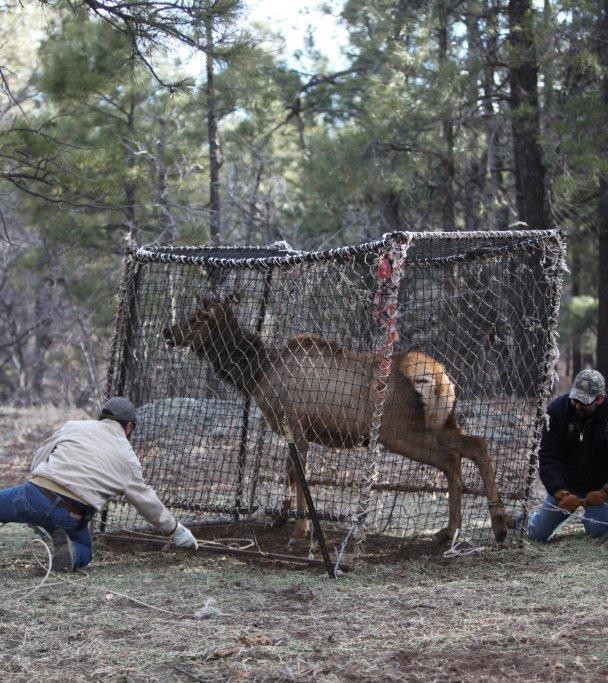Elk are roaming around the woods with collars around their necks. In the forest near Flagstaff, elk are being outfitted to tell researchers what they and other animals need to navigate through urban sprawl, climate change and large restoration projects.
For Arizona Game and Fish Department wildlife biologist Jeff Gagnon, the job of collaring an elk is somewhat like a rodeo event. Within minutes, he and a team of wildlife managers can calm a frightened animal that might weigh as much as a thousand pounds.
"We fit the collar to make sure the animal has some space and isn't being choked," he says.
The collar is programmed to fall off in a few months. But in the meantime, every two hours a GPS unit is sending signals to satellites that are sending signals to biologists.
Gagnon has been tracking some 130 elk around major highways, including interstates 17 and 40.
"We know where the animals are, what kind of habitat they are using and what barriers are stopping them. For a lot of animals when we fragment their habitat, they can't get to resources like summer or winter range. We also run the risk of isolating or breaking up the herd, which can lead to a smaller gene pool and a weaker species."
Researchers like Northern Arizona University's Paul Beier, a conservation biology and wildlife ecology professor in the School of Forestry, says this information is critically important to keep animals from stepping into danger or even extinction.
"With climate change, we have the situation where habitat is literally moving out from under the feet of wildlife," he says. "In order for these species to stay where they are, in terms of a healthy population, they have to move."
Beier is developing maps detailing links for wild areas, or wildlife corridors, to help land managers understand how animals move across the land.
"We're creating landscapes that are more permeable than the landscapes we had a decade or two decades ago," he says.
"If you provide habitat for the large species, you bring the others along," says Arizona Game and Fish Department Habitat Program Manager Sarah Reif. "Elk, mule deer, pronghorn antelope -- these are the big guys we manage for because of public safety on highways and roads, and because they have the biggest home ranges."
Pronghorn have long been a symbol of the West, but researchers say barriers like canals, fences and highways have had a substantial impact on the population.
"In Arizona, the numbers declined from about 45,000 animals in the early 1900s to roughly 7,500 in 2002," says Reif. "Since then, we have recovered the population to somewhere around 11,000 but we still have a lot of work to do to connect pronghorn habitats."
With information about wildlife movement, highways are becoming less of a hindrance, and safer for wildlife and people. Groups like the Arizona Department of Transportation, Elk Society, Rocky Mountain Elk Foundation and Federal Highway Administration are funding research and passageways.
For example, along State Route 260 near Payson, highway improvement projects have included wildlife elevated crossings. "Animals are using the crossings," says Gagnon, "and collisions between elk and motorists have been reduced by at least 85 percent."
Wally Covington, executive director of the Ecological Restoration Institute at NAU, says managing for wildlife corridors is increasingly important as forests are restored on a landscape scale.
"Across hundreds of thousands of acres, natural habitat can be restored. Wildlife can self-regulate. Predator-prey dynamics can keep populations in a sustainable, steady state that's characteristic of the evolutionary environment."
Wearing high-tech necklaces, today's elk may well be leading the way for tomorrow's wildlife corridors.
"We're doing something that really matters," says Beier. "It's a fabulous triple-win situation. It's better for people, less road kill and more wildlife movement."
Bonnie Stevens is the Program Director for Public Information and Education at the Ecological Restoration Institute at Northern Arizona University.
Link to the AZ Daily Sun Story Here




